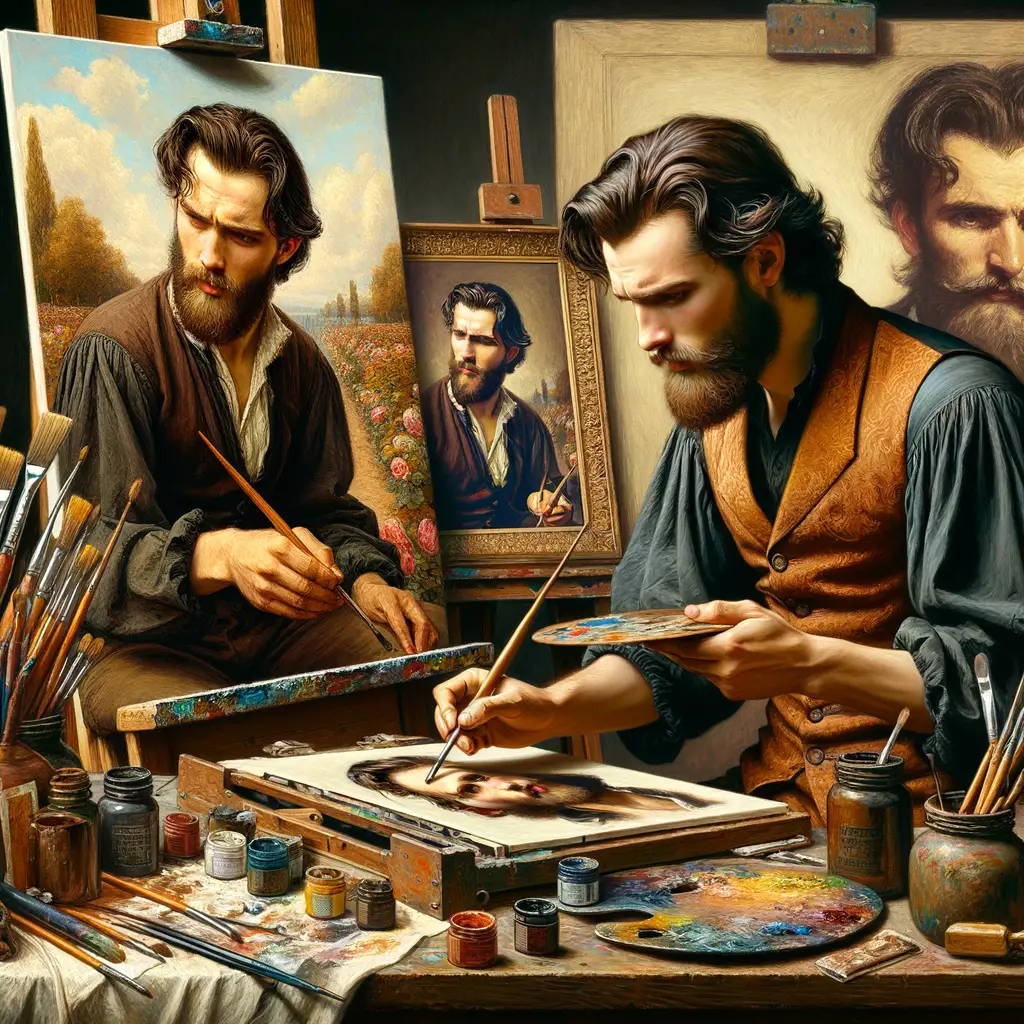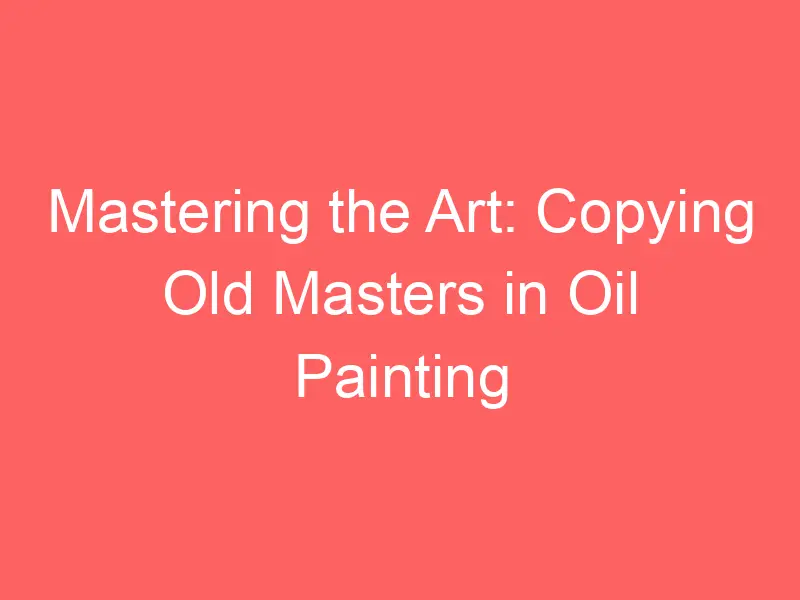
Introduction to the Art of Copying Paintings
Copying paintings, particularly those of the Old Masters, is a time-honored tradition in the art world. It’s a practice that has been carried out by aspiring artists for centuries, and it remains a valuable method of study even today. In this blog post, we will delve into the importance of studying and reproducing Old Masters paintings and understanding the art of oil painting.
- The Importance of Studying and Reproducing Old Masters Paintings
- Understanding the Art of Oil Painting
Studying and reproducing the works of Old Masters is a crucial step in an artist’s education. The Old Masters, who include artists like Leonardo da Vinci, Rembrandt, and Michelangelo, were masters of technique, composition, and color. By copying their works, artists can gain a deeper understanding of these elements and how they come together to create a compelling image. Wikipedia provides a comprehensive list of Old Masters whose works are worth studying.
Oil painting is a traditional art form that has been used for centuries. It’s a versatile medium that allows for a range of effects, from thin, transparent glazes to thick, impasto strokes. Understanding the art of oil painting involves learning about the properties of oil paint, the tools used to apply it, and the techniques for mixing colors and creating texture. For more information on the art of oil painting, you can refer to this Wikipedia article.
In the following sections, we will delve deeper into the techniques used by the Old Masters, provide a practical guide to copying paintings, and showcase successful replicas of Old Masters paintings. Stay tuned to learn more about this fascinating aspect of art.
Old Masters Oil Painting Techniques
The art of oil painting has been perfected over centuries by the Old Masters. These artists, who include the likes of Rembrandt, Vermeer, and Van Eyck, developed techniques that are still studied and admired today. Let’s delve into some of these techniques and how they can be used in copying Old Masters’ paintings.
Understanding the Techniques in Copying Old Masters
Copying the Old Masters’ paintings is not just about replicating their work. It’s about understanding their techniques, their use of light, shadow, color, and texture. Here are some key aspects to consider:
- Study of the Old Masters painting styles
- Learning from Old Masters: The use of light and shadow
- Masterpiece oil painting replicas: The use of color and texture
Each Old Master had a unique style. For instance, Rembrandt was known for his dramatic use of light and shadow, while Vermeer’s paintings are characterized by a delicate handling of color and detail. Studying their styles can provide valuable insights into their techniques.
The Old Masters were masters of chiaroscuro, the contrast between light and dark. They used this technique to create depth and volume in their paintings. By studying their use of light and shadow, you can learn to create a similar sense of realism in your own work.
Color and texture are crucial elements in oil painting. The Old Masters used a variety of pigments and mediums to achieve their desired effects. By studying their use of color and texture, you can learn to replicate the richness and depth of their work.
In conclusion, copying the Old Masters’ paintings is a valuable exercise in understanding and mastering the techniques of oil painting. By studying their styles, use of light and shadow, and use of color and texture, you can learn to create your own masterpieces.
Art of Copying Paintings: Practical Guide
Copying the works of the Old Masters is not just a way to create beautiful art, but also a fantastic method to learn and understand their techniques. This guide will help you navigate the process of reproducing these masterpieces.
Oil Painting Reproduction Techniques
Oil painting is a complex art form that requires patience, skill, and the right materials. Here are some practical steps to guide you through the process.
- Choosing the right materials for oil painting like the Old Masters
- Step-by-step guide to reproducing Old Masters paintings
- Common challenges and how to overcome them
The Old Masters used a variety of materials in their oil paintings, including pigments, oils, and brushes. It’s essential to choose high-quality materials to recreate the depth and richness of their works. For example, using a canvas primed with gesso can provide a smooth surface for your painting, similar to what the Old Masters would have used.
Reproducing an Old Master painting involves careful observation, planning, and execution. Start by studying the original painting in detail. Sketch the composition, noting the placement of objects and figures. Then, block in the main colors and shapes, working from dark to light. Finally, add details and highlights to bring the painting to life. Remember, practice makes perfect!
One of the most common challenges in reproducing Old Masters paintings is achieving the same level of detail and depth. This can be overcome by practicing your brushwork and studying the techniques used by the Old Masters. Another challenge is matching the colors exactly. Experiment with mixing your paints to get the right shades and tones. Remember, patience is key in this process.
Copying the works of the Old Masters is a rewarding journey that can enhance your painting skills. With the right materials, careful observation, and plenty of practice, you can create beautiful reproductions of these timeless masterpieces.
Case Studies: Successful Replicas of Old Masters Paintings
Let’s dive into some real-world examples of how artists have successfully replicated the works of Old Masters. These case studies will provide valuable insights into the process and techniques used in creating masterpiece oil painting replicas.
Learning from the Best: Examples of Masterpiece Oil Painting Replicas
-
Case study 1: Reproducing a Rembrandt
Rembrandt, a Dutch artist from the 17th century, is known for his unique use of light and shadow. One successful replica of his work is the “Self-Portrait with Two Circles”. The artist who replicated this painting spent countless hours studying Rembrandt’s technique. The result was a stunning replica that captured the depth and texture of the original. The artist used a mixture of raw umber and lead white for the underpainting, just as Rembrandt did. This case study shows the importance of understanding and replicating the original artist’s technique. Learn more about this Rembrandt painting on Wikipedia.
-
Case study 2: Copying a Vermeer
Vermeer, another Dutch artist from the same era as Rembrandt, is renowned for his detailed and realistic depictions of domestic life. A successful replica of his painting “Girl with a Pearl Earring” was achieved by an artist who carefully studied Vermeer’s use of color and light. The artist used a technique called glazing, where thin layers of transparent paint are applied over a monochrome underpainting. This technique allowed the artist to achieve the luminous quality that Vermeer’s paintings are known for. Read more about this Vermeer painting on Wikipedia.
-
Key takeaways from successful replicas
These case studies highlight the importance of studying the original artist’s technique and understanding the materials they used. Replicating a masterpiece isn’t just about copying what you see; it’s about understanding how the original artist achieved their effects and applying those techniques to your own work. It’s a process of learning, experimenting, and refining until you’ve created a replica that truly captures the spirit of the original.
Conclusion: The Artistic Value of Copying Old Masters
As we draw this discussion to a close, it’s important to reflect on the artistic value of copying Old Masters. This practice is not just a replication of art, but a journey of personal growth and a tribute to the historical significance of art.
- How copying Old Masters contributes to personal artistic growth
- The role of copying in the art world: A historical perspective
Copying the works of Old Masters is a time-honored tradition in the art world. It’s a form of practice that allows artists to study and understand the techniques and styles of the greats, thereby enhancing their own skills. By copying, artists are able to dissect the composition, color palette, and brushwork of the masters, gaining insights that contribute to their personal artistic growth. As Pablo Picasso once said, “Good artists copy, great artists steal.”
Historically, copying has played a significant role in the art world. Many famous artists, like Vincent van Gogh, began their careers by copying the works of Old Masters. This practice was not seen as plagiarism, but rather as a form of homage and a way to learn from the best. It’s also worth noting that many art schools still encourage students to copy Old Masters as part of their training.
In conclusion, copying Old Masters is not just about reproducing art—it’s about understanding the techniques, styles, and ideas of the greats, and using this knowledge to enhance one’s own artistic abilities. It’s a practice that has stood the test of time, proving its value in the personal and professional growth of artists around the world.



















